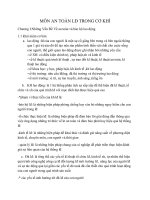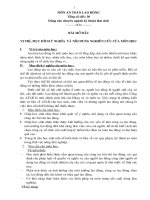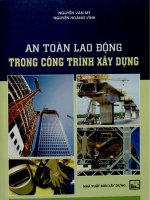AN TOÀN LAO ĐỘNG TRONG CÔNG TÁC THI CÔNG HẦM
Bạn đang xem bản rút gọn của tài liệu. Xem và tải ngay bản đầy đủ của tài liệu tại đây (26.52 MB, 65 trang )
AN TOÀN LAO ĐỘNG TRONG CÔNG TÁC THI CÔNG HẦM
Prepared by the ITA Working Group
“Health and Safety”
and financed by TBG and ITA
MỤC LỤC
1
2
2.1
2.2
2.2
2.4
3.
3.1
3.2
3.3
3.4
3.5
4
4.1
4.2
4.3
4.4
4.5
4.6
5
5.1
5.2
5.3
5.4
5.5
5.6
5.7
5.8
5.9
5.10
6
6.1
Dụng cụ cho thợ hầm
Xây dựng, lắp đặt hầm
Thông gió
Ánh sáng
Lắp đặt thiết bị điện và đường dây dẫn điện
Thiết bị thoát hiểm
Đường đi đến nơi làm việc
Đường đi bộ đối với nơi không có xe rails hoạt động
Đường đi bộ đối với nơi có xe tải hoạt động
Vận tải hành khách
Vận chuyển trong giếng thông gió
Sử dụng thang
Đào đất đá
Khoan bằng tay
Khoan bằng thiết bị Jumbos
Nạp thuốc nổ vào lổ khoan
Nổ mìn
Đào đất đá bằng máy đào
Đào bằng thiết bị Roadheader
Chống đỡ ban đầu
Đào bóc vỏ
Đào bóc bằng thủ công
Lắp đặt lưới thép
Lắp đặt vòm
Lắp đặt bu lông neo đá
Phun bê tông
Điều khiển phun bê tông
Phun bê tông (quy trình khô)
Bảo trì dụng cụ/thiết bị phun bê tông
Dời vật chướng ngại
Vận chuyển
Bốc xếp đất đào
4
12
14
16
18
20
22
24
26
28
30
32
34
36
38
40
42
44
46
48
50
52
54
56
58
60
62
64
66
68
70
72
6.2
6.3
6.4
6.5
6.6
6.7
6.8
6.9
6.10
7
7.1
7.2
7.3
8
8.1
8.2
8.3
8.4
8.5
9
9.1
9.2
10
10.1
10.2
Đi lại qua khu vực đang thi công
Lái xe qua mép hố đào
Xoay đầu xe trong hầm
Lùi xe trong hầm
Khu vực hẹp nơi sử dụng phương tiện xe rail
Vận chuyển bằng băng tải
Vận chuyển bằng băng tải (tại vị trí chuyển vật liệu)
Vận chuyển trong giếng hầm (vận chuyển vật liệu đào)
Vận chuyển trong giếng hầm (hàng hóa)
Lớp lót sau cùng
Lắp đặt cốt thép
Di chuyển cốt pha
Làm việc ở trong cốt pha hầm
TBM-Work (Tunnel Boring Machine)
Bảo dưỡng hoàn thiện mặt hầm
Máy lắp neo
Điều khiển/hướng dẫn xe kéo thi công hầm
Lắp những võ hầm (hầm lớn)
Lắp những võ hầm (hầm nhỏ)
Những chất độc trong khí để thở
Khí thải từ động cơ diesel
Chất thải từ bụi
Sơ cứu
Trình tự cứu nạn
Trình tự cứu nạn
74
76
78
80
82
84
86
88
90
92
94
96
98
100
102
104
106
108
110
112
114
116
118
120
122
1
4
The Tunneller’s Equipment
5
1.1
Personal Safety Outfit
6
7
• hard hat
• safety shoes (boots)
• gloves
• protective clothing
• other personnel protective equipment
(depending on working process)
1.2
Personal Safety Outfit
3
1
2
4
5
7
6
8
9
1 • eye protection
2 • hard hat
3 • respiratory protection
4 • gloves
5 • ear muffs
6 • ear plugs
7 • safety boots
1.3
Personal Safety Outfit
4
2
3
5
1
6
10
11
1 • waterproof clothing 2
• self rescuer
3 • reflecting warning vest 4 •
hard hat for shotcreting 5 •
hand lamp
6 • cap lamp
2
12
Tunnel Installations
13
2.1
14
Ventilation
• sufficient ventilation
• test and measure at regular intervals
• avoid re-circulation from the portal
Ventilation
Fresh air ducts
• extend close to the working face
• avoid kinks
• repair any damage immediately
15
2.2
Lighting
16
17
• light all places of work and access ways
• install special lighting at dangerous places
• use flashing warning lights adjacent to dangerous locations
• all light fittings should be protected against ingress of water
• check, maintain and clean lighting installations regularly
• safety lighting system (emergency lighting)
2.3
Electrical Installations
and Supply Lines
18
19
• all electrical installations to be set, modified and repaired
by qualified electricians;
(work on high voltage network [transmission or power lines]
only permitted with a special authorisation)
• adhere to national requirements
• use earth fault circuit breaker ≤ 30 mA
• support cables and pipelines securely on brackets
against risks of impact, bending, abrasion, tension
• use appropriate fittings and coupling system
2.4
Emergency Equipment
20
21
• give regular instructions on emergency drills
and rescue procedures
• carry out emergency drills with the participation
of the fire-brigade
• provide effective emergency communications
(check regularly)
• set up first aid and rescue installations
• set up appropriate fire extinguishers
(observe fire classification)
• provide self-rescuers in sufficient number and size
3
22
Walkways to Working Places
23
3.1
24
Danger
• being struck
Walkways with Non-rail Operation
Protection
• separate paths for vehicles and pedestrians
• install guard rails alongside the pedestrian path
• maintain the vehicle path surface and wet it to reduce dust
25
3.2
26
Danger
• being struck
• slipping and tripping hazards
Walkways with Track Operation
Protection
• separate path for vehicles and pedestrians
• put locos at the ends
• provide a video monitoring system to observe
ahead of train when pushing
• in longer tunnels use rail personnel carriers
27
3.3
28
Danger
• falling
• being struck
Passenger Transport
Protection
• do not ride on equipment
• provide and use suitable vehicles for passenger transport
29
3.4
30
Danger
• falling from the ladder
• being crushed by the skip
• fall of excavated material
Transport in Shafts
Protection
• install safety hoops and intermediate landings
• do not overload skip
• use either stair tower (diagonal ladderways)
or personnel lift
• do not carry heavy items
31
3.5
32
Danger
• falling
Access and Work Places
on Ladders
Protection
• remove damaged ladders from site
• put both feet on the rung and do not
reach over too far while working
• do only simple and close work on ladders
33
4
34
Excavation
35
4.1
36
Danger
• slipping and falling
• dust, noise
Manual Drilling
Protection
• adopt safe working position - worker as well as drilling tool
• wet drilling
• wear hearing and eye protection
37
4.2
38
Danger
• being knocked over, being crushed, being struck
• rock fall
• dust, noise
Jumbos
Protection
• keep away from danger area
• wet drilling
• wear hearing protection
39
4.3
40
Danger
• accidental detonation by drilling into explosives
• being knocked over or crushed by drilling boom
• falling
Charging the Blast Holes
Protection
• only charge after the whole face has been completely drilled
• work can only be carried out under the supervision
of an authorised and qualified blasting specialist
• use working platforms
41
4.4
42
Danger
• fly rock
• toxic fumes resulting from blasting
Blasting
Protection
• keep away from the area to be blasted
• switch off the ventilation completely before blasting
• switch on the ventilation at full capacity after blasting
• the team has to stay in a protective shelter
(safety container or blasting shelter) after blasting
• in small tunnels the protective shelter can be installed
in a niche
43
4.5
44
Danger
• being crushed
• being run over
Excavation with Excavator
Protection
• do not enter danger zone
• light the working area adequately
• use acoustic signal when driving backwards
45
4.6
46
Danger
• dust containing quartz (silicosis)
• being crushed
• being run over
• flying debris
Excavation with Roadheader
Protection
• install effective dust control system
• install waterspray system at cutting head
• do not enter machine danger zone
• light the working area adequately
47









